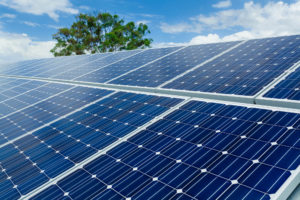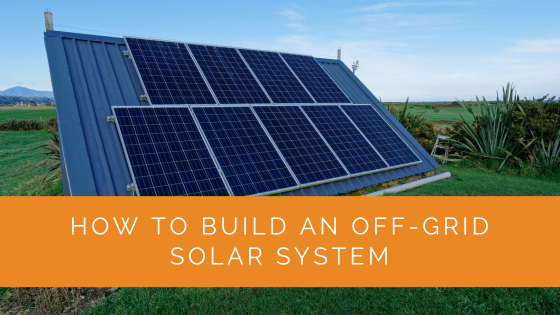In today’s world, off-grid solar systems offer a sustainable and independent way to harness solar energy for your power needs. Building your off-grid solar system provides self-sufficiency and reduces reliance on the grid. This comprehensive guide will take you through the step-by-step process of creating your off-grid solar system, enabling you to generate clean energy and embrace a more sustainable lifestyle.
Contents
- 1 Key Takeaways
- 2 Assessing Your Energy Needs
- 3 Load Analysis and System Design
- 4 Sizing Your Solar Array
- 5 Selecting the Inverter and Charge Controller
- 6 Battery Bank Sizing and Configuration
- 7 Wiring and Electrical Connections
- 8 Mounting and Installing Solar Panels
- 9 Connecting the Inverter, Charge Controller, and Battery Bank
- 10 System Testing and Commissioning
- 11 Maintenance and Troubleshooting
- 12 Case Study: Building an Off-Grid Solar System for a Remote Cabin
- 13 Expert Insights From Our Solar Panel Installers About Off-Grid Solar Systems
- 14 Experience Solar Excellence with Us!
- 15 Conclusion
Key Takeaways
- Assess your energy needs accurately by creating a detailed list of appliances and devices to power, considering their power ratings, seasonal variations, and future energy demands.
- Perform load analysis and system design to determine peak power demand, prioritize energy-efficient appliances, and select appropriate components like solar panels and batteries.
- Properly size your solar array, select suitable inverters and charge controllers, configure your battery bank, ensure proper wiring and electrical connections, and conduct system testing, maintenance, and troubleshooting for a reliable off-grid solar system.
Assessing Your Energy Needs
To ensure a successful off-grid solar system, it’s crucial to assess your energy requirements accurately. Start by creating a detailed list of all the appliances, devices, and lights you need to power. Please take note of their power ratings, typically measured in watts (W). Consider each item’s continuous and peak power demands to calculate the overall power needed for your system. Don’t forget to account for seasonal variations and potential future energy demands.
Analyzing your energy needs will help you determine the size and capacity of the off-grid solar system you’ll require. It will also be a foundation for making informed decisions during the system design phase.
Load Analysis and System Design
Once you have assessed your energy needs, the next step is to perform a thorough load analysis and system design. Identify the peak power demand by considering the simultaneous operation of multiple appliances and devices. Determine the maximum power required by summing up the power ratings of all the items operating simultaneously.
Conducting a load analysis allows you to understand the power consumption patterns and prioritize energy-efficient appliances. It helps you optimize the system design and select the appropriate components, such as solar panels, batteries, and inverters.
During the system design process, consider the expected daily energy consumption and the energy you need to store in your battery bank to cover periods without sufficient sunlight. Carefully evaluate the specific requirements of each appliance to ensure compatibility with your off-grid system.
Sizing Your Solar Array
Sizing your solar array is crucial in building an off-grid solar system. It involves determining the total wattage needed to meet your energy demands. To calculate the required wattage, multiply your average daily energy consumption by the hours of sunlight available in your location. This estimation takes into account the solar potential and system efficiency.
Consider factors such as solar panel efficiency, tilt angle, and shading when determining the number of solar panels needed. Given the available space and environmental conditions, selecting panels that will provide maximum power output is important. By correctly sizing your solar array, you can ensure that your off-grid system generates enough electricity to meet your yearly needs.

Selecting the Inverter and Charge Controller
Selecting the right inverter and charge controller is crucial for efficiently operating your off-grid solar system. The inverter converts the DC power generated by your solar panels into usable AC power, allowing you to run standard appliances. It’s important to choose an inverter that matches the system’s voltage and can handle the maximum power requirements of your load.
Consider the waveforms generated by the inverter. Pure sine wave inverters provide high-quality power and are suitable for most appliances, while modified sine wave inverters are more affordable but may not be compatible with certain devices. Assess your load requirements and select the appropriate inverter.
The charge controller regulates the charging process of your battery bank, ensuring that the batteries are charged efficiently and protected from overcharging. Select a charge controller that can handle the voltage and current produced by your solar panels. It should also have the necessary features to monitor and protect your battery bank.
Battery Bank Sizing and Configuration
Designing the battery bank involves determining the capacity and configuration of your batteries. To calculate the required battery capacity, consider factors such as depth of discharge (DoD), autonomy days, and battery chemistry. The depth of discharge refers to the percentage of the battery’s capacity that can be safely utilized without causing damage. Aiming for a conservative depth of discharge is recommended to extend the battery’s lifespan.
Autonomy days are when your off-grid system can operate solely on battery power without receiving solar input. This factor is influenced by your energy consumption patterns and the expected number of days without sufficient sunlight. Consider your location, weather conditions, and energy requirements to determine the desired autonomy days.
Battery chemistry is an important consideration when selecting your system’s battery type. Lead-acid batteries are commonly used due to their affordability and reliability. They are available in two main types: flooded lead acid (FLA) and sealed lead acid (SLA). FLA batteries require regular maintenance, while SLA batteries are maintenance-free. Lithium-ion batteries offer higher energy density, longer lifespan, and faster charging capabilities but come at a higher cost.
Configuring the batteries involves connecting them in series and parallel to achieve the desired voltage and capacity. Series connections increase the overall voltage, while parallel connections increase the capacity and current output. Determine the appropriate combination based on your system voltage requirements and the battery capacity needed.
Wiring and Electrical Connections
Your off-grid solar system’s wiring and electrical connections are crucial for safe and efficient operation. Use high-quality cables and connectors suitable for your system’s voltage and current. Ensure proper wire sizing to minimize voltage drop and optimize energy transmission.
Follow the wiring diagram provided by the manufacturer for your specific components. Properly connect the solar panels to the charge controller, ensuring correct polarity. Connect the charge controller to the battery bank and the inverter, again paying close attention to polarity and following manufacturer guidelines.
Implement proper grounding techniques to ensure electrical safety and protect against potential electrical faults. Install fuses and circuit breakers to protect the system from overcurrent and short circuits. It’s recommended to consult a professional electrician or solar installer to ensure compliance with local electrical codes and regulations.

Mounting and Installing Solar Panels
The correct installation of solar panels is vital to maximizing their energy production. Select a suitable mounting system based on your installation location, whether on the roof, ground, or pole-mounted. Ensure the mounting structure is securely anchored and capable of withstanding environmental conditions.
Position the solar panels to receive maximum sunlight exposure throughout the day. Consider the tilt angle and orientation that optimize the energy capture based on location. Proper alignment and shading avoidance will help maximize the solar panel system’s efficiency.
Follow the manufacturer’s instructions for the correct wiring of the solar panels. Connect them in the desired configuration, either series or parallel, to achieve the desired voltage and current output. Use appropriate connectors and make sure all connections are secure and weatherproof.
Connecting the Inverter, Charge Controller, and Battery Bank
Follow the manufacturer’s guidelines to connect the inverter, charge controller, and battery bank. Pay close attention to polarity and ensure all connections are tight and secure. Connect the inverter to the battery bank, ensuring the proper gauge and type of cables handle the maximum current.
Connect the charge controller to the solar panels, ensuring the wiring is correctly sized for the current and voltage of the system. Double-check the connections to ensure they are properly tightened and insulated. Configure the charge controller settings according to the manufacturer’s instructions to optimize battery charging and protect the system.
System Testing and Commissioning
After the installation, thoroughly testing and commissioning your off-grid solar system is crucial. Verify the voltage, current, and power outputs of the solar panels, inverter, and battery bank. Monitor the system’s performance over several days, observing its energy production, battery charging, and overall functionality. Use a multimeter or monitoring software to track key parameters such as voltage, current, and state of charge.
During testing, ensure the system operates within expected parameters and meets your energy needs. Monitor the battery bank’s charging and discharging cycles to confirm that it can handle the load and provide sufficient power during periods without sunlight.
Perform a commissioning process by documenting the system’s specifications, configurations, and test results. This documentation will serve as a valuable reference for future maintenance and troubleshooting.
Maintenance and Troubleshooting
Regular maintenance is essential to keep your off-grid solar system operating efficiently and prolong its lifespan. Here are some key maintenance tasks to consider:
- Clean the solar panels regularly to remove dirt, dust, and debris that can reduce their energy production.
- Monitor the battery bank’s state of charge and voltage levels. Perform periodic maintenance, such as equalization or desulfation, as the battery manufacturer recommends.
- Inspect all electrical connections, including wiring, terminals, and connectors, to ensure they are tight, secure, and corrosion-free.
- Check the performance of the charge controller and inverter, monitoring their temperature, voltage, and current output. Address any abnormal readings or malfunctions promptly.
- Regularly review system performance data and compare it to your initial energy needs assessment. Make adjustments as necessary to optimize the system’s efficiency.
- Record maintenance activities, including dates, tasks performed, and any issues encountered. This documentation will help track the system’s performance over time and aid in troubleshooting.
Troubleshooting is key to identifying and resolving the problem in case of malfunctions or unexpected issues. Start by checking all connections, ensuring they are secure and properly insulated. Verify that all components, including the solar panels, charge controller, inverter, and batteries, are functioning correctly. Consult the manufacturer’s documentation or seek professional assistance if needed.
Remember to prioritize safety when performing maintenance or troubleshooting activities. Follow proper safety procedures and guidelines, such as wearing protective equipment and de-energizing the system before making any electrical connections or adjustments.
By conducting regular maintenance and promptly addressing any issues, you can ensure your off-grid solar system’s long-term reliability and efficiency, allowing you to enjoy the benefits of sustainable and independent power generation.
Case Study: Building an Off-Grid Solar System for a Remote Cabin
Background
Solar Panels Network USA recently completed a project for a client who needed an off-grid solar system for their remote cabin. The client wanted a sustainable and reliable energy solution to ensure energy independence and reduce environmental impact.
Project Overview
The objective was to design and install an off-grid solar system capable of powering the cabin’s essential appliances and providing sufficient energy storage to handle periods without sunlight. The remote location required a robust and self-sufficient setup.
Implementation
- Energy Needs Assessment:
- Conducted a detailed analysis of the client’s energy requirements, listing all appliances and devices to be powered.
- Calculated the total energy consumption, accounting for seasonal variations and future expansion needs.
- Load Analysis and System Design:
- Performed a load analysis to determine peak power demand.
- Designed the system to prioritize energy-efficient appliances and optimize component selection.
- Solar Array Sizing:
- Determined the required wattage by multiplying daily energy consumption by available sunlight hours.
- Selected high-efficiency monocrystalline solar panels to maximize energy production.
- Component Selection:
- Chose a pure sine wave inverter for compatibility with all appliances.
- Selected a high-quality charge controller to regulate battery charging.
- Battery Bank Configuration:
- Designed a battery bank using maintenance-free sealed lead-acid batteries.
- Configured the batteries in series and parallel to achieve the desired voltage and capacity.
- Wiring and Installation:
- Followed proper wiring techniques, ensuring secure and insulated connections.
- Mounted the solar panels on a ground-mounted structure for optimal sunlight exposure.
- System Testing and Commissioning:
- Conducted comprehensive testing to verify the system’s performance.
- Monitored key parameters and adjusted settings for optimal operation.
Results
The off-grid solar system successfully met the client’s energy needs, providing reliable power to the remote cabin. The system’s performance exceeded expectations, ensuring energy independence and reducing the client’s reliance on fossil fuels. The client reported significant savings on energy costs and appreciated the system’s low maintenance requirements.
Summary
This project highlights the importance of meticulous planning and execution in building an off-grid solar system. Solar Panels Network USA delivered a sustainable and reliable energy solution for the remote cabin by accurately assessing energy needs, designing an efficient system, and selecting high-quality components. Our expertise and commitment to excellence ensure that our clients can enjoy the benefits of clean and independent energy.
Expert Insights From Our Solar Panel Installers About Off-Grid Solar Systems
Designing and installing an off-grid solar system requires a thorough understanding of your energy needs. Proper assessment and planning ensure that the system is capable of meeting those needs sustainably and reliably.
Senior Solar Installer
The key to a successful off-grid system is efficient energy storage. Choosing the right battery bank and maintaining it properly can significantly enhance the system’s performance and longevity.
Lead Solar Technician
Regular maintenance and monitoring are crucial for the optimal functioning of off-grid solar systems. Keeping the components clean and checking connections periodically can prevent potential issues and ensure consistent energy output.
Solar Installation Manager
Experience Solar Excellence with Us!
Trust in Solar Panels Network USA, where our seasoned experts deliver top-quality solar solutions for homes and businesses nationwide. With a legacy of countless successful installations and a commitment to sustainable energy, we’re your reliable partner in the solar journey. Ready for a brighter, eco-friendly future? Call us now at (855) 427-0058 and harness the sun’s power!
Conclusion
Building your off-grid solar system is an empowering and rewarding DIY project. You can create a reliable and sustainable off-grid energy solution by assessing your energy needs, designing the system, sizing the solar array, selecting the right components, and ensuring proper wiring and connections.
Harnessing the power of solar energy allows you to reduce your carbon footprint, gain energy independence, and enjoy the benefits of a clean and renewable energy source. Whether you want to power a remote cabin or a tiny home or reduce your reliance on the grid, building an off-grid solar system offers countless advantages.
Remember to follow safety guidelines, consult local regulations, and seek professional assistance. Proper planning, installation, and maintenance allow you to enjoy an off-grid solar system’s maximum power and energy independence. Embrace the sun’s power and embark on your journey toward a more sustainable future.
About the Author
Solar Panels Network USA stands at the forefront of solar energy solutions, driven by a team of seasoned solar engineers and energy consultants. With over decades of experience in delivering high-quality solar installations and maintenance, we are committed to promoting sustainable energy through customer-centric, tailored solutions. Our articles reflect this commitment, crafted collaboratively by experts to provide accurate, up-to-date insights into solar technology, ensuring our readers are well-informed and empowered in their solar energy decisions.

